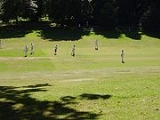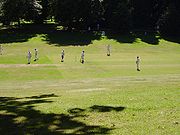
Cockington
Encyclopedia
Cockington is a village in Torquay
in the English county of Devon
. It is a picturesque village, with old cottages within its boundaries. It is about a half a mile away from Torquay.
with evidence of two hill fort
s on either side of Cockington valley. Little is known about Cockington from that point up until the remains of a small Saxon
village were found near the Drum Inn. The evidence from this village shows that it was primarily a fishing and farming village. The first official documentation of the village was in the 10th century. The manor was owned by Alric the Saxon, before William Hostiarus, William de Falesia and Robert FitzMartin, who passed it down to his son Roger, who renounced his name to become Roger de Cockington. The Cockington family owned Cockington Estate from 1048–1348. The Cary
family owned the court from 1375 to 1654. It was then sold to the Mallock family, a family of rich silversmith
s from Exeter
, who owned it from 1654 to 1932 when they sold the estate to the Torquay Corporation.
 The park which is now home to the cricket
The park which is now home to the cricket
grounds was originally a medieval deer park
. Cricket started to be played on it in 1947. The current cricket pavilion was built after the original burnt down ten years ago.
, it opened in 1936 to replace the old ale-house
.
by the Cary family to house the poor and those who could not work within the village. When the Mallock family took over the Cockington estate
, the almshouses fell into disrepair. They were rebuilt between 1790 and 1810.
workshops.
In her youth, Agatha Christie
regularly visited Cockington. Her novel Why Didn't They Ask Evans?
is dedicated to Christopher Mallock. The Mallock family were friends of Christie's from the years before her first marriage. The Mallocks staged amateur theatricals at Cockington Court, in which Christie, managing to overcome her usual crippling shyness, took part.
was born in Cockington in about 1615. Robert Sweet
(1782-1835), horticulturalist and author, was also born in the village.
Torquay
Torquay is a town in the unitary authority area of Torbay and ceremonial county of Devon, England. It lies south of Exeter along the A380 on the north of Torbay, north-east of Plymouth and adjoins the neighbouring town of Paignton on the west of the bay. Torquay’s population of 63,998 during the...
in the English county of Devon
Devon
Devon is a large county in southwestern England. The county is sometimes referred to as Devonshire, although the term is rarely used inside the county itself as the county has never been officially "shired", it often indicates a traditional or historical context.The county shares borders with...
. It is a picturesque village, with old cottages within its boundaries. It is about a half a mile away from Torquay.
History
The village was probably founded 2,500 years ago during the Iron AgeIron Age
The Iron Age is the archaeological period generally occurring after the Bronze Age, marked by the prevalent use of iron. The early period of the age is characterized by the widespread use of iron or steel. The adoption of such material coincided with other changes in society, including differing...
with evidence of two hill fort
Hill fort
A hill fort is a type of earthworks used as a fortified refuge or defended settlement, located to exploit a rise in elevation for defensive advantage. They are typically European and of the Bronze and Iron Ages. Some were used in the post-Roman period...
s on either side of Cockington valley. Little is known about Cockington from that point up until the remains of a small Saxon
Anglo-Saxons
Anglo-Saxon is a term used by historians to designate the Germanic tribes who invaded and settled the south and east of Great Britain beginning in the early 5th century AD, and the period from their creation of the English nation to the Norman conquest. The Anglo-Saxon Era denotes the period of...
village were found near the Drum Inn. The evidence from this village shows that it was primarily a fishing and farming village. The first official documentation of the village was in the 10th century. The manor was owned by Alric the Saxon, before William Hostiarus, William de Falesia and Robert FitzMartin, who passed it down to his son Roger, who renounced his name to become Roger de Cockington. The Cockington family owned Cockington Estate from 1048–1348. The Cary
George Cary (of Cockington)
Sir George Cary , of Cockington in Devon, was an English administrator and Member of Parliament who held various offices in Ireland. He was treasurer-at-war to the Earl of Essex's campaign in Ireland in 1599, and was appointed a Lord Justice in September 1599 and again in 1603...
family owned the court from 1375 to 1654. It was then sold to the Mallock family, a family of rich silversmith
Silversmith
A silversmith is a craftsperson who makes objects from silver or gold. The terms 'silversmith' and 'goldsmith' are not synonyms as the techniques, training, history, and guilds are or were largely the same but the end product varies greatly as does the scale of objects created.Silversmithing is the...
s from Exeter
Exeter
Exeter is a historic city in Devon, England. It lies within the ceremonial county of Devon, of which it is the county town as well as the home of Devon County Council. Currently the administrative area has the status of a non-metropolitan district, and is therefore under the administration of the...
, who owned it from 1654 to 1932 when they sold the estate to the Torquay Corporation.
Cricket Pavilion and grounds

Cricket
Cricket is a bat-and-ball game played between two teams of 11 players on an oval-shaped field, at the centre of which is a rectangular 22-yard long pitch. One team bats, trying to score as many runs as possible while the other team bowls and fields, trying to dismiss the batsmen and thus limit the...
grounds was originally a medieval deer park
Medieval deer park
A medieval deer park was an enclosed area containing deer. It was bounded by a ditch and bank with a wooden park pale on top of the bank. The ditch was typically on the inside, thus allowing deer to enter the park but preventing them from leaving.-History:...
. Cricket started to be played on it in 1947. The current cricket pavilion was built after the original burnt down ten years ago.
Drum Inn
The Drum Inn is the local pub/restaurant in Cockington. Designed by Edwin LutyensEdwin Lutyens
Sir Edwin Landseer Lutyens, OM, KCIE, PRA, FRIBA was a British architect who is known for imaginatively adapting traditional architectural styles to the requirements of his era...
, it opened in 1936 to replace the old ale-house
Brewery
A brewery is a dedicated building for the making of beer, though beer can be made at home, and has been for much of beer's history. A company which makes beer is called either a brewery or a brewing company....
.
The Almshouses
The Almshouses consist of seven terraced cottages built during the reign of King James I of EnglandJames I of England
James VI and I was King of Scots as James VI from 24 July 1567 and King of England and Ireland as James I from the union of the English and Scottish crowns on 24 March 1603...
by the Cary family to house the poor and those who could not work within the village. When the Mallock family took over the Cockington estate
Estate (house)
An estate comprises the houses and outbuildings and supporting farmland and woods that surround the gardens and grounds of a very large property, such as a country house or mansion. It is the modern term for a manor, but lacks the latter's now abolished jurisdictional authority...
, the almshouses fell into disrepair. They were rebuilt between 1790 and 1810.
Cockington Court
Cockington Court was built over the remains of a medieval court. A far cry from the days of the Cary family when it was an actual court, it is now filled with various arts and craftsArts and crafts
Arts and crafts comprise a whole host of activities and hobbies that are related to making things with one's hands and skill. These can be sub-divided into handicrafts or "traditional crafts" and "the rest"...
workshops.
In her youth, Agatha Christie
Agatha Christie
Dame Agatha Christie DBE was a British crime writer of novels, short stories, and plays. She also wrote romances under the name Mary Westmacott, but she is best remembered for her 66 detective novels and 14 short story collections , and her successful West End plays.According to...
regularly visited Cockington. Her novel Why Didn't They Ask Evans?
Why Didn't They Ask Evans?
Why Didn't They Ask Evans? is a work of detective fiction by Agatha Christie, first published in the United Kingdom by the Collins Crime Club in September 1934 and in the United States by Dodd, Mead and Company in 1935 under the title of The Boomerang Clue.The UK edition retailed at seven shillings...
is dedicated to Christopher Mallock. The Mallock family were friends of Christie's from the years before her first marriage. The Mallocks staged amateur theatricals at Cockington Court, in which Christie, managing to overcome her usual crippling shyness, took part.
Other notable buildings
- A church that has probably been around since the 11th century.
- A water mill that is in the middle of the village;
- Cockington Forge, which has been in the same place in the village for 500 years.
Notable residents
Chronologer Robert CaryRobert Cary (chronologer)
Robert Cary was an English churchman, for a short while archdeacon of Exeter, known as a chronologist.-Life:Born at Cockington or Berry-Pomeroy, Devon, he was the second son of George Cary of Cockington by Elizabeth, daughter of Sir Edward Seymour. He was admitted a commoner of Exeter College,...
was born in Cockington in about 1615. Robert Sweet
Robert Sweet (botanist)
Robert Sweet was an English botanist, horticulturist and ornithologist.Born at Cockington near Torquay, Devonshire, England in 1783, Sweet worked as a gardener from the age of sixteen, and became foreman or partner in a series of nurseries. He was associated with nurseries at Stockwell, Fulham...
(1782-1835), horticulturalist and author, was also born in the village.

